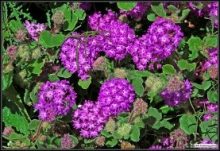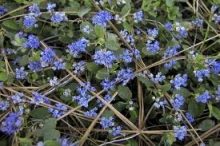| Abronia maritime (Coastal) |  | Abronia maritima is a species of sand verbena known by the common name red sand verbena. This is a beach-adapted perennial plant native to the coastlines of southern California, including the Channel Islands, and northern Baja California. |
| Abronia villosa (Inland) |  | Abronia villosa is a species of sand-verbena known by the common name desert sand-verbena. It is native to the deserts of the southwestern United States and northern Mexico and the southern California and Baja coast. |
| Adenostoma fasciculatum (Coastal/Inland) |  | Adenostoma fasciculatum (chamise or greasewood) is a flowering plant native to California and northern Baja California. This shrub is one of the most widespread plants of the chaparral biome. Adenostoma fasciculatum is an evergreen shrub growing to 4m tall, with dry-looking stick-like branches. The leaves are small, 4–10 mm long and 1mm broad with a pointed apex, and sprout in clusters from the branches. |
| Arctostaphylos uva-ursi (Coastal/Inland) |  | Arctostaphylos uva-ursi is a plant species of the genus Arctostaphylos (manzanita). Its common names include kinnikinnick and pinemat manzanita, and it is one of several related species referred to as bearberry. |
| Arctostaphylos edmundsii (Coastal/Inland) |  | Arctostaphylos edmundsii, with the common name Little Sur manzanita, is a species of manzanita. This shrub is endemic to California where it grows on the coastal bluffs of Monterey County. |
| Arctostaphylos hookeri (Coastal/Inland) |  | Arctostaphylos hookeri is a species of manzanita known by the common name Hooker's manzanita. Arctostaphylos hookeri is a low shrub which is variable in appearance and has several subspecies. The Arctostaphylos hookeri shrub is endemic to California where its native range extends from the coastal San Francisco Bay Area to the Central Coast. |
| Baccharis pilularis (Coastal/Inland) |  | Baccharis pilularis, called Coyote Brush, Chaparral Broom, and Bush Baccharis, is a shrub in the Asteraceae that grows in California, Oregon, Baja California, and New Mexico. The plants are found in a variety of habitats, from coastal bluffs, oak woodlands, and grasslands, including hillsides and canyons, below 2,000 feet (610 m). |
| Ceanothus (Coastal/Inland) |  | Ceanothus is a genus of about 50–60 species of shrubs or small trees in the family Rhamnaceae. The genus is confined to North America, with the center of its distribution in California. The majority of the species are evergreen, but the handful of species adapted to cold winters are deciduous. |
| Ceanothus hearstiorum (Coastal/Inland) |  | Ceanothus hearstiorum is a species of flowering shrub known by the common names Hearst Ranch buckbrush and Hearst's ceanothus. This Ceanothus is endemic to California, where it grows wild only on the hilly coastline of San Luis Obispo County. |
| Dudleya pulverulenta (Coastal) |  | Dudleya pulverulenta is a succulent plant known by the common names chalk lettuce, chalk dudleya, and chalk liveforever. This dudleya is native to the southwestern United States and northern Mexico, where it is found in steep open rocky areas in coastal and inland mountains and desert foothills, such as the Santa Monica Mountains. |
| Lessingia filaginifolia (Coastal/Inland) |  | Lessingia filaginifolia, a dicot, is a perennial herb that is native to California and is found only slightly beyond California borders. It’s habitat is coastal and dunes. It needs very little water, can take full sun exposure and is also very winter hardy. |
| Salvia (Inland) |  | Salvia is the largest genus of plants in the mint family, Lamiaceae, with approximately 700–900 species of shrubs, herbaceous perennials, and annuals. It is one of several genera commonly referred to as sage. Salvia species include annual, biennial, or perennial herbs, along with woody subshrubs. |
| Salvia Mellifera (Coastal/Inland) |  | Salvia mellifera (Black sage) is a small, highly aromatic, evergreen shrub of the genus Salvia (the sages) native to California, and Baja California, Mexico. It is common in the coastal sage scrub of Southern California and northern Baja California and lower chaparral plant communities. |
| Salvia munzii (Coastal/Inland) |  | Salvia munzii is a species of sage known by the common name Munz's sage (named for California botanist Philip A. Munz). It is native to northern Baja California, Mexico, and it can be found in a few locations just north of the border in San Diego County, California. |
| Verbena lilacina / De La Mina Verbena (Coastal) |  | A drought tolerant California native, it attracts butterflies and is perfect for planting in natural gardens and meadows. Beautiful in borders or tucked into window boxes, hanging baskets, or containers. Evergreen. |